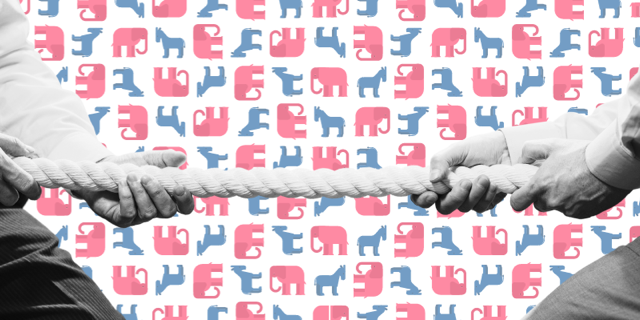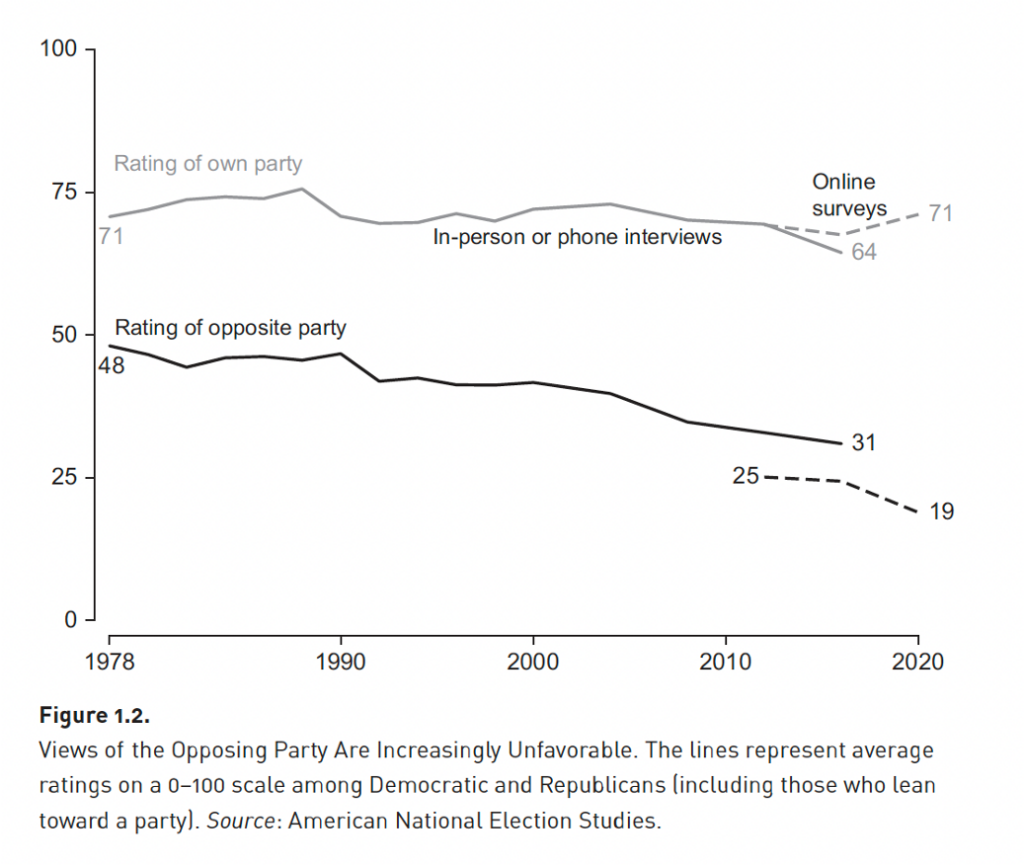
In a recent piece on U.S. political parties, the writer Matthew Yglesias said:
We have a lot of partisanship, but that’s largely negative partisanship, not affective affiliation with the party you usually vote for.
Now, this is an ancillary point in a longer piece focused on political party organizations rather than the psychology of partisanship among voters. The longer piece is well worth reading. But this assertion isn’t really correct. And the fact that Yglesias felt safe making it almost as an aside, without citing evidence, just goes to show how easy it is to believe.
Negative partisanship is the idea that people are motivated by dislike for the opposite party rather than positive feelings for their own party. There is no doubt that this dislike exists and has become more prevalent. You can see it in people’s average ratings of their own party and the opposite party on a 0-100 scale known as a “feeling thermometer.” Here is a graph from “The Bitter End,” my book with Chris Tausanovitch and Lynn Vavreck on the 2020 election.

This data, which comes from the American National Election Studies, shows that between 1978 and 2016, average ratings of the opposite party declined from 48 to 31 when respondents were interviewed by a live interviewer. In 2012-2020, when the ANES also conducted some or almost all interviews using a self-completed online mode, ratings of the opposite party were even lower. This is because people are more willing to express negative viewpoints in self-completed surveys.
This trend is what’s known as “affective polarization“ or, later, “negative partisanship.“ It’s real! But it’s not the sum total of partisanship.
A useful corrective is this piece by Amber Hye-Yon Lee, Yphtach Lelkes, Carlee Hawkins, and Alex Theodoridis titled “Negative partisanship is not more prevalent than positive partisanship.“
The authors begin by noting that it would be odd if partisanship, long considered a central social identity, did not reflect positive identification with a party:
…negative partisanship seemingly contradicts decades of social psychological research on social identity theory, which holds that identifying with social groups first produces in-group favoritism, which then leads to negativity towards out-groups under certain conditions.
The percentage of Americans who call themselves a “strong” Democrat or Republican has increased from 24% in 1976 to 44% in 2020. It would be odd if this increase was only an expression of dislike for the other party. It’s like if people who identify as diehard Yankees fans didn’t really love the Yankees but just hated the Red Sox.
Lee and her co-authors then show that even as of 2020, Americans’ dislike of the other party was not necessarily greater than their affection for their own party. This is based on the measures graphed above.
Next, they explicitly asked partisan respondents in a separate 2016 survey whether their partisanship was based on identifying with their party or not identifying with the other party. Positive partisanship was more prevalent than negative partisanship:

They then did a similar analysis with a battery of questions that asked about partisanship in positive or negative ways. For example, one of the positive partisanship questions was, “When I talk about this party, I say ‘we’ instead of ‘them’” and a negative partisanship question was, “When people criticize this party, it makes me feel good.” Here’s what they found:
Fifty-one percent of respondents show higher positive partisanship scores than negative partisanship scores, 35% show higher negative partisanship scores than positive partisanship scores, and 15% are equally positive as they are negative.
Interestingly, these alternative measures of positive and negative party identification actually weren’t strongly correlated with the most prominent measure of negative partisanship: the 0-100 feeling thermometer scale. The authors note:
…our study shows that feeling thermometer ratings of the out-party are only weakly correlated with other direct measures of positive and negative partisan attachment. Even if people are showing more animosity towards the other side when measured with the feeling thermometer, that does not constitute strong evidence that their partisan identity is predicated on that out-party dislike.
Finally, they had participants play a game designed to see whether they would actively favor their own political party and/or hurt the other party. In one version of the game, respondents were given tokens and then allowed to decide whether to keep the tokens, donate them to a “group fund” that would benefit their team, and/or donate them to a “competitive fund” that would benefit their team and hurt the other team by reducing the number of tokens they would receive. Participants were told that their team were members of their own party. The experiment randomly varied whether participants were told that the other team was of the same party as them or the opposite party.
When participants were told that the members of the other team were their co-partisans, they tended to donate more to the group fund – meaning, they favored their own team more than they tried to hurt the other. This makes sense since both teams were co-partisans.
When told that the other team was composed of opposite partisans, there was a bit more donating to the “competitive fund,” but not much. The authors write:
The results indicate that people are not necessarily focused on hurting out-partisans in the opposing group any more than on benefiting their own group of co-partisans, which does not fit with the negative partisanship view.
To be sure, you can find groups of Americans whose partisanship appears more negative than positive. Perhaps ironically, these people tend to be self-described “independents” who say they merely “lean” toward a party. Overall, the authors are careful not to suggest that partisanship is exclusively or mostly positive.
But people shouldn’t claim that partisanship is largely or entirely negative, either. Indeed, given that Americans already exaggerate how much the other party hates their party, it seems especially important not to further this misperception.



